Design and Simulation of a Digital Twin Mobility Concept: An Electric Aviation System Dynamics Case Study with Capacity Constraints
Abstract
:Featured Application
Abstract
1. Introduction
2. Methodology
2.1. Methodological Fundamentals
2.2. Research Methodology
3. Conceptual Model Development
3.1. Conceptual Framework for Mobility Needs and Supply Options
3.2. Conceptual Management Model for Air Mobility
3.3. Electric Aviation Mobility Elements
3.4. Service-Oriented On-Demand Air Mobility Model
4. Simulation Model Design
4.1. Methodological Steps
4.2. Target System
4.3. Model Design for the Case Study
- When an aircraft unit is required at a vertiport and it is not available.
- When an aircraft unit requires a place to land and park at a vertiport and no place is available.
- The simulation period was set equal to 1 min.
- The time horizon was selected for 4 days, a total of 5760 periods.
- Every day, there was a redistribution of the aircraft units between vertiports. In the model, this occurred every 1440 periods. This function could be disabled.
- There were 15 vertiports with distances between 100 and 300 km among them. All origin–destination pairs were available by request to customers within the 15 vertiports as potential connections.
- The electric aircraft units had a range of 300 km.
- The flight transportation lead times between the 15 vertiports were calculated with a normal distribution defined by a mean and a standard deviation. However, it was possible to define the mean, the standard deviation, the maximum and the minimum per possible transport route, with a total of 225 combinations.
- If an aircraft unit could not land in a vertiport due to the location having reached its capacity, the aircraft would wait until space became available.
- If a customer flight request for an aircraft unit could not be assigned due to the vertiport being empty, then the customer would wait until an aircraft unit was available in the same vertiport.
- The electric aviation cycle in the simulation model followed the status shown in Figure 11. Between two flights, four cases could occur before the next flight order would be performed; direct to the next flight; charging required; maintenance required; charging and maintenance required.
4.4. Simulation Logic
- Demand of mobility between stations with origin and destination. For each time period, flight requests for each origin–destination combination were generated. Therefore, customized air mobility scenarios could be generated to simulate the on-demand nature. The data were read by the system dynamics simulation model.
- Average transportation lead time between all combinations of vertiports, standard deviation of the transportation lead time between vertiports, as well as the maximum and minimum values for the lead times between locations were also defined and read from the simulation model. Therefore, the model allowed changes to the lead time parameters from its origin–destination combination
4.5. Simulation Models and Scenarios
5. Case Study Results
6. Discussion
- The real-time monitoring of vertiports with their capacity. Allowing users of smart-device apps to view where and what options are available for on-demand transport. Short-term reservations could be an option, such as within 30-min time frames.
- An app could also connect users and allow them to meet and transfer seats and improve the utilization rate of the e-aircraft while minimizing the use of the capacities at the stations and reducing wait times.
- A team could be allocated to redistribute aircraft to meet on-demand bookings and prevent overcrowding at vertiports.
- Additional services could be provided, such as a business option for those who need on-demand transportation and can afford to pay extra for customized processing such as longer reservation windows or long-term bookings.
7. Conclusions
- An extension of the conceptual model for an integrated mobility concept with scalability.
- A detailed analysis of the factors of the simulation model.
- An application of the model for route scheduling and traffic management as well as for monitoring indicators for the continuous optimization of the network, balancing mobility needs against operational costs, and environmental impacts.
- An extension of the functionality of the simulation model including an economic model with price fluctuations, economic cycles, the evolution of shared mobility, population characteristics and demographics, the impact of global events such as COVID-19, increased flexibility of the distribution network, different regions and stations, and the mobility vehicle life cycle.
- An application of the conceptual model methodology and the simulation model to a real-world mobility network for a region.
Author Contributions
Funding
Institutional Review Board Statement
Informed Consent Statement
Conflicts of Interest
References
- Zanin, M.; Lillo, F. Modelling the air transport with complex networks: A short review. Eur. Phys. J. Spéc. Top. 2013, 215, 5–21. [Google Scholar] [CrossRef] [Green Version]
- Holmes, B.J. A Vision and Opportunity for Transformation of On-Demand Air Mobility. In Proceedings of the 16th AIAA Aviation Technology, Integration, and Operations Conference, Washington, DC, USA, 13–17 June 2016; p. 3465. [Google Scholar]
- Friedrich, C.; Robertson, P.A. Hybrid-electric propulsion for automotive and aviation applications. CEAS Aeronaut. J. 2015, 6, 279–290. [Google Scholar] [CrossRef] [Green Version]
- Urban, M.; Kluge, U.; Plötner, K.O.; Barbeito, G.; Pickl, S.; Hornung, M. Modelling the European Air Transport System: A System Dynamics Approach. Deutsche Gesellschaft für Luft-und Raumfahrt-Lilienthal-Oberth eV. 2017. Available online: https://www.dglr.de/publikationen/2017/450125.pdf (accessed on 6 January 2022).
- Legeza, E.; Selymes, P.; Torok, A. Investigation of European air transport traffic by utility-based decision model. Aviation 2010, 14, 90–94. [Google Scholar] [CrossRef]
- Lijesen, M.G.; Nijkamp, P.; Rietveld, P. Measuring competition in civil aviation. J. Air Transp. Manag. 2002, 8, 189–197. [Google Scholar] [CrossRef]
- Jain, A.; Martinetti, A.; van Dongen, L. Mapping the Needs of Design for Maintenance in Electric Aviation; Elsevier: Amsterdam, The Netherlands, 2021; Available online: https://ssrn.com/abstract=3945107 (accessed on 6 January 2022).
- Al Haddad, C.; Chaniotakis, E.; Straubinger, A.; Plötner, K.; Antoniou, C. Factors affecting the adoption and use of urban air mobility. Transp. Res. Part A Policy Pract. 2020, 132, 696–712. [Google Scholar] [CrossRef]
- Sun, X.; Wandelt, S.; Husemann, M.; Stumpf, E. Operational Considerations regarding On-Demand Air Mobility: A Literature Review and Research Challenges. J. Adv. Transp. 2021, 2021, 3591034. [Google Scholar] [CrossRef]
- Abu-Rayash, A.; Dincer, I. Analysis of mobility trends during the COVID-19 coronavirus pandemic: Exploring the impacts on global aviation and travel in selected cities. Energy Res. Soc. Sci. 2020, 68, 101693. [Google Scholar] [CrossRef] [PubMed]
- Kadyk, T.; Winnefeld, C.; Hanke-Rauschenbach, R.; Krewer, U. Analysis and Design of Fuel Cell Systems for Aviation. Energies 2018, 11, 375. [Google Scholar] [CrossRef] [Green Version]
- Seeley, B.A.; Seeley, D.; Rakas, J. A Report on the Future of Electric Aviation; The Regents of the University of California: Berkeley, CA, USA, 2020. [Google Scholar]
- Brelje, B.J.; Martins, J.R. Electric, hybrid, and turboelectric fixed-wing aircraft: A review of concepts, models, and design approaches. Prog. Aerosp. Sci. 2019, 104, 1–19. [Google Scholar] [CrossRef]
- Westin, L. Towards Electric Aviation in the Kvarken Region; Kvarken Council: Vaasa, Finland, 2021. [Google Scholar]
- Brown, A.; Harris, W. A Vehicle Design and Optimization Model for On-Demand Aviation. In Proceedings of the 2018 AIAA/ASCE/AHS/ASC Structures, Structural Dynamics, and Materials Conference, Kissimmee, FL, USA, 8–12 January 2018; p. 0105. [Google Scholar]
- Paproth, Y.; Adam, F.; Stich, V.; Kampker, A. Model for future thin-haul air mobility demand in Germany. In Proceedings of the 2020 IEEE International Conference on Engineering, Technology and Innovation (ICE/ITMC), Cardiff, UK, 15–17 June 2020; pp. 1–8. [Google Scholar]
- Mandel, B.; Gaudry, M.; Ungemach, D. Europe-Wide Aviation Connectivity Measures and the PATH Theorem; Université de Montréal: Montréal, QC, Canada, 2017; Volume 21, Agora Jules Dupuit, Publication AJD-161. [Google Scholar]
- Schäfer, A.W.; Barrett, S.R.; Doyme, K.; Dray, L.M.; Gnadt, A.R.; Self, R.; O’Sullivan, A.; Synodinos, A.P.; Torija, A.J. Technological, economic and environmental prospects of all-electric aircraft. Nat. Energy 2019, 4, 160–166. [Google Scholar] [CrossRef] [Green Version]
- Brown, A.; Harris, W.L. Vehicle Design and Optimization Model for Urban Air Mobility. J. Aircr. 2020, 57, 1003–1013. [Google Scholar] [CrossRef]
- Ploetner, K.O.; Al Haddad, C.; Antoniou, C.; Frank, F.; Fu, M.; Kabel, S.; Llorca, C.; Moeckel, R.; Moreno, A.T.; Pukhova, A.; et al. Long-term application potential of urban air mobility complementing public transport: An upper Bavaria example. CEAS Aeronaut. J. 2020, 11, 991–1007. [Google Scholar] [CrossRef] [PubMed]
- Campanelli, B.; Fleurquin, P.; Eguiluz, V.M.; Ramasco, J.J.; Arranz, A.; Etxebarria, I.; Ciruelos, C. Modeling reactionary delays in the European air transport network. In Proceedings of the Fourth SESAR Innovation Days, Madrid, Spain, 25–27 November 2014. [Google Scholar]
- Gomez, P.; Malik, F.; Oeller, K.H. Systemmethodik-Grundlagen Einer Methodik zur Erforschung und Gestaltung Komplexer Soziotechnischer Systeme; Haupt, P., Translator; Paul Haupt: Bern, Swizertland, 1975. [Google Scholar]
- Patzak, G. Systemtechnik—Planung Komplexer Innovativer Systeme: Grundlagen, Methoden, Techniken; Springer: Berlin/Heidelberg, Germany, 2013. [Google Scholar]
- Haberfellner, R.; Nagel, P.; Becker, M.; Büchel, A.; von Massow, H. “Systems Engineering” Methodik und Praxis; Industrielle Organisation: Zürich, Switzerland, 2002. [Google Scholar]
- Moron, O. Unterstützung Strategischer Entscheidungen in Produzierenden Unternehmen; Shaker: Aachen, Germany, 1998. [Google Scholar]
- Friedrich, M. Beurteilung Automatisierter Prozesskoordination in der Technischen Auftragsabwicklung; Shaker: Aachen, Germany, 2002. [Google Scholar]
- Franz, V. (Ed.) Simulation von Unikatprozessen: Neue Anwendungen aus Forschung und Praxis; 2. IBW-Workshop; 24. März 2011 an der Universität Kassel; Kassel University Press GmbH: Kassel, Germany, 2011; Volume 2. [Google Scholar]
- Domschke, W.; Drexl, A. Einführung in Operations Research; 7. Überarb. Aufl.: Mit 63 Tabellen (No. 30389); Department of Business Administration, Economics and Law, Institute for Business Studies (BWL), Darmstadt Technical University: Darmstadt, Germany, 2007. [Google Scholar]
- Richtlinie, V.D.I. Blatt 1: Simulation von Logistik-, Materialfluß-und Produktionssystemen–Grundlagen; Beuth: Berlin, Germany, 2000. [Google Scholar]
- Schuh, G.; Stich, V. Logistikmanagement: Handbuch Produktion und Management 6; 2. Vollst. Neu Bearb. und Erw. Imprint; VDI-Buch, 6; Springer: Berlin/Heidelberg, Germany, 2013. [Google Scholar]
- Bleicher, K. Das Konzept Integriertes Management: Visionen-Missionen-Programme; Campus Verlag: Frankfurt, Germany, 2011. [Google Scholar]
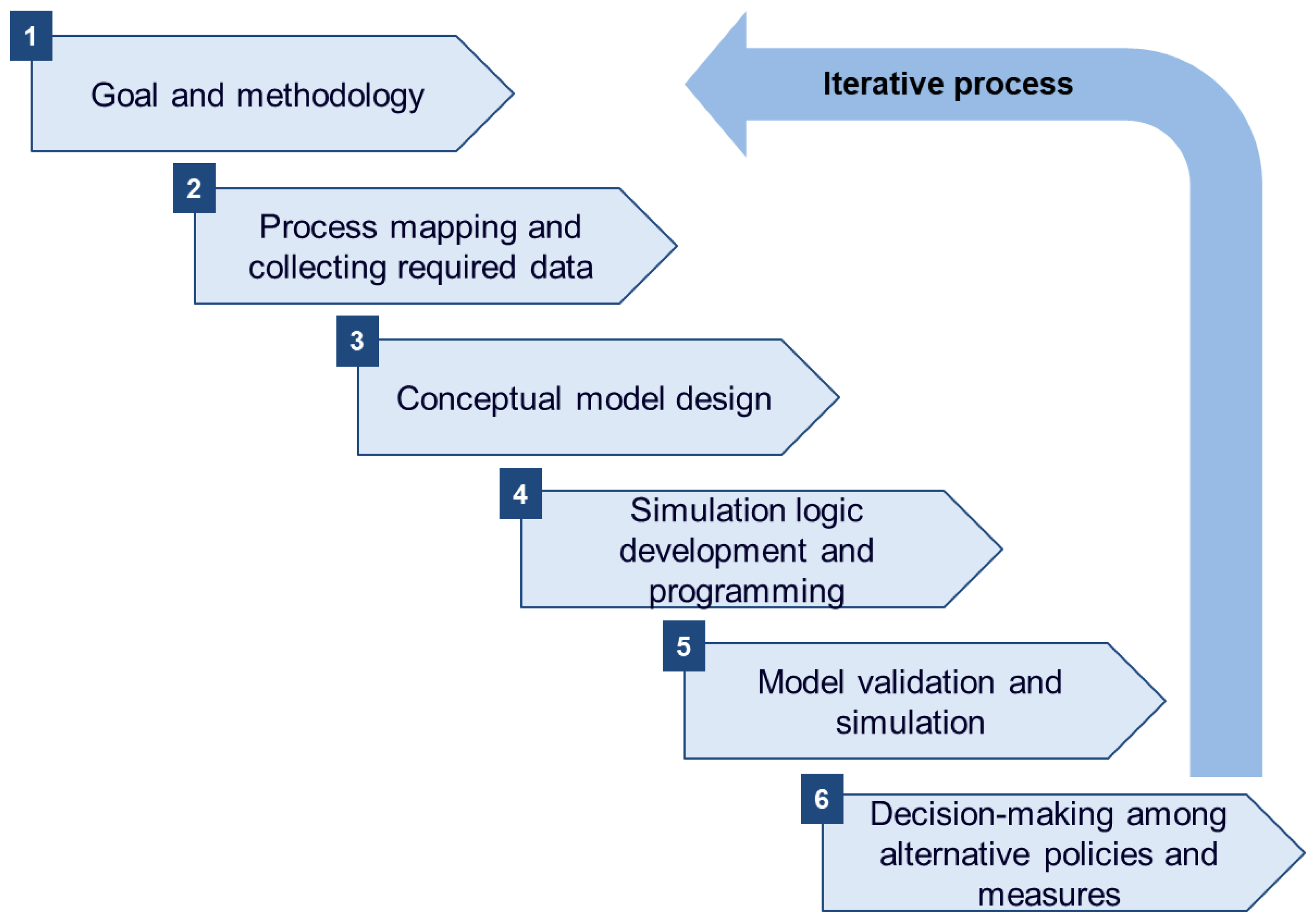
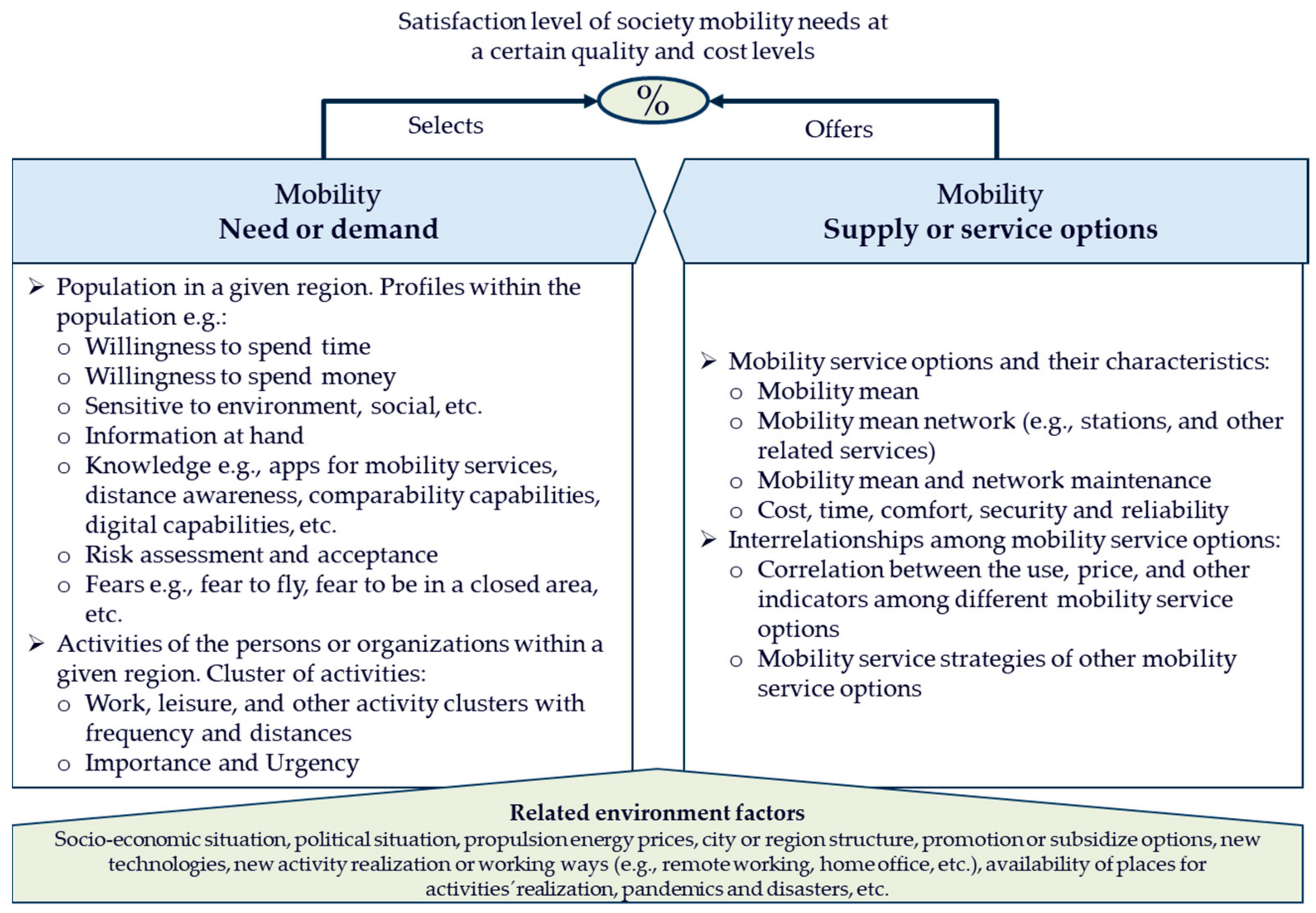
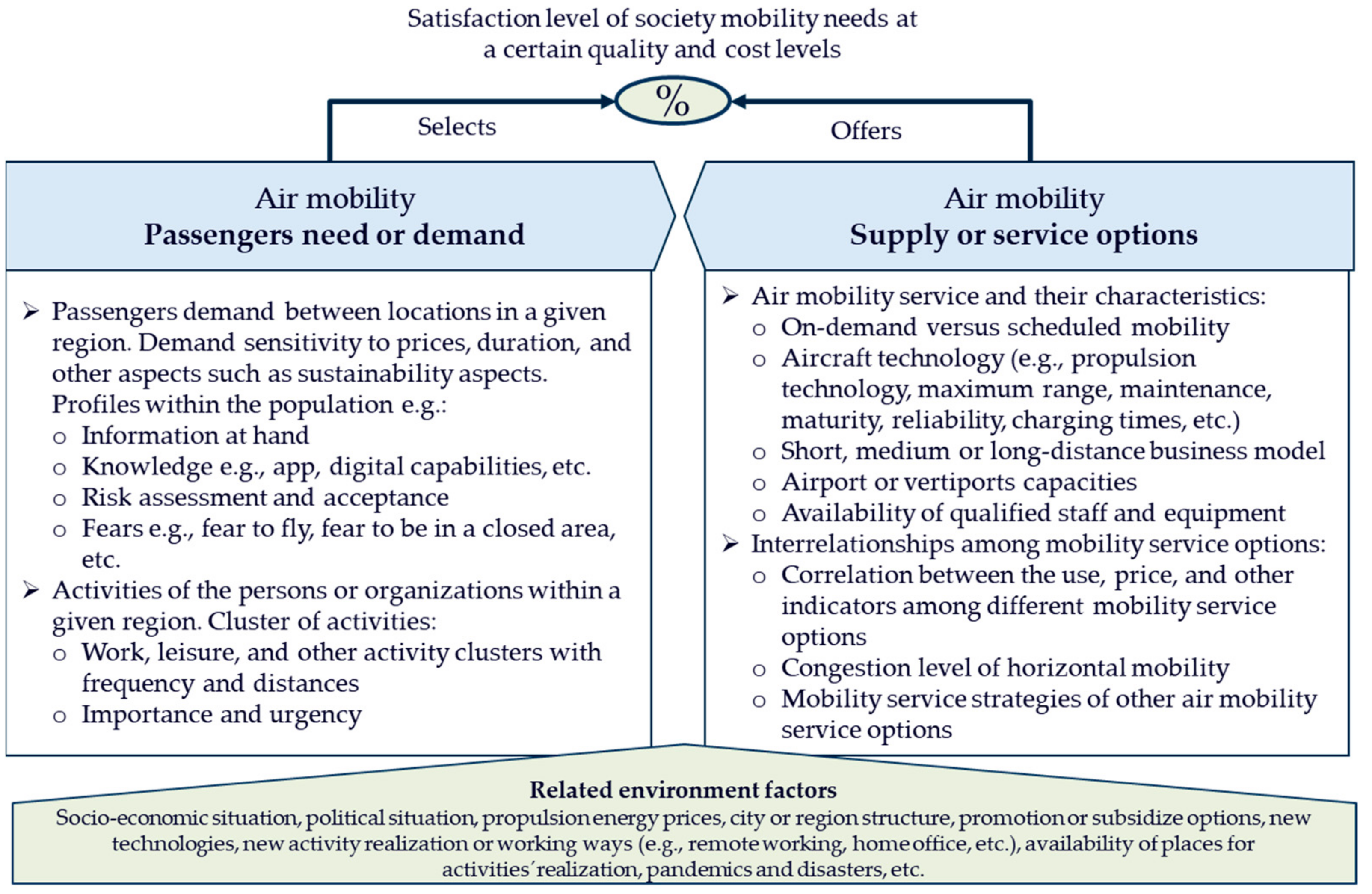
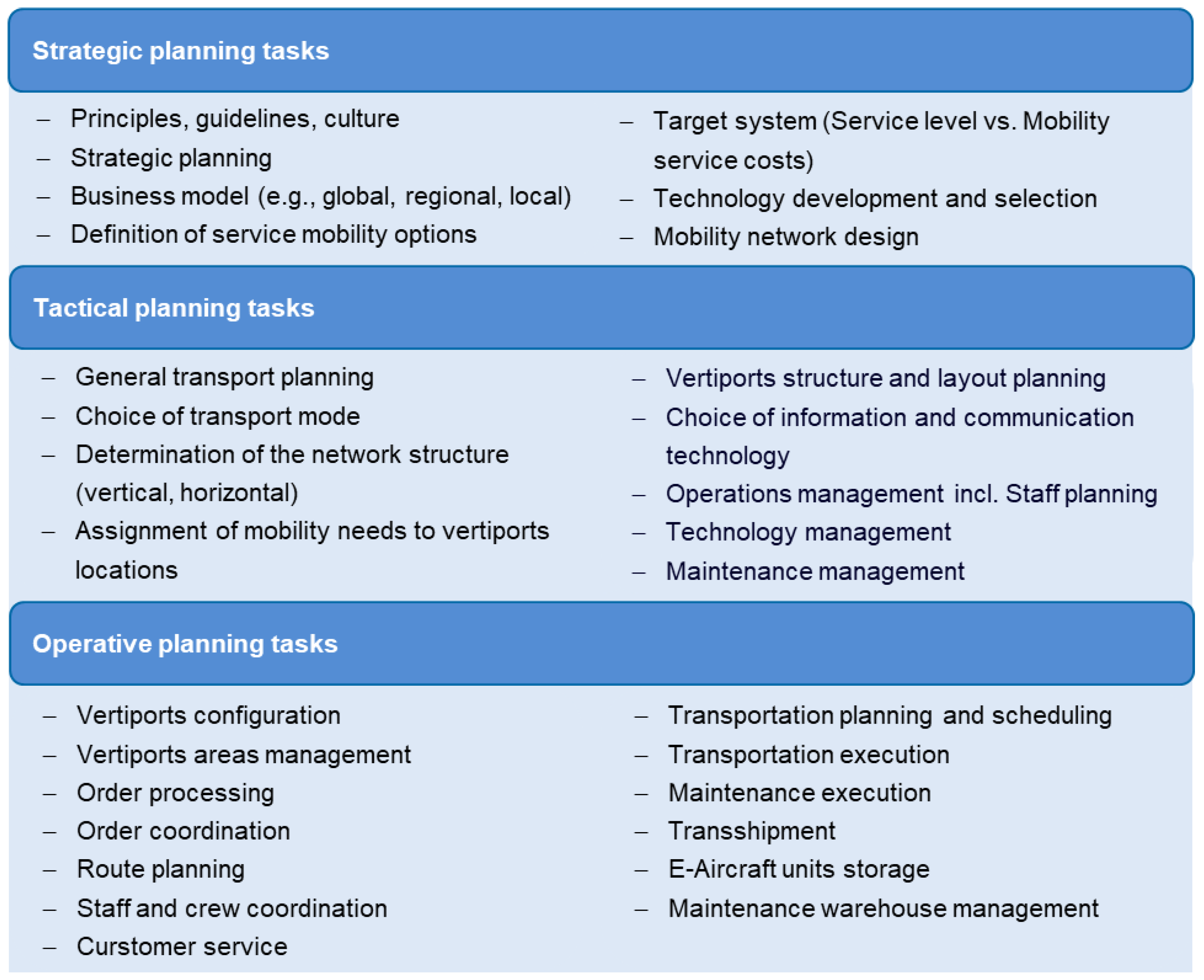



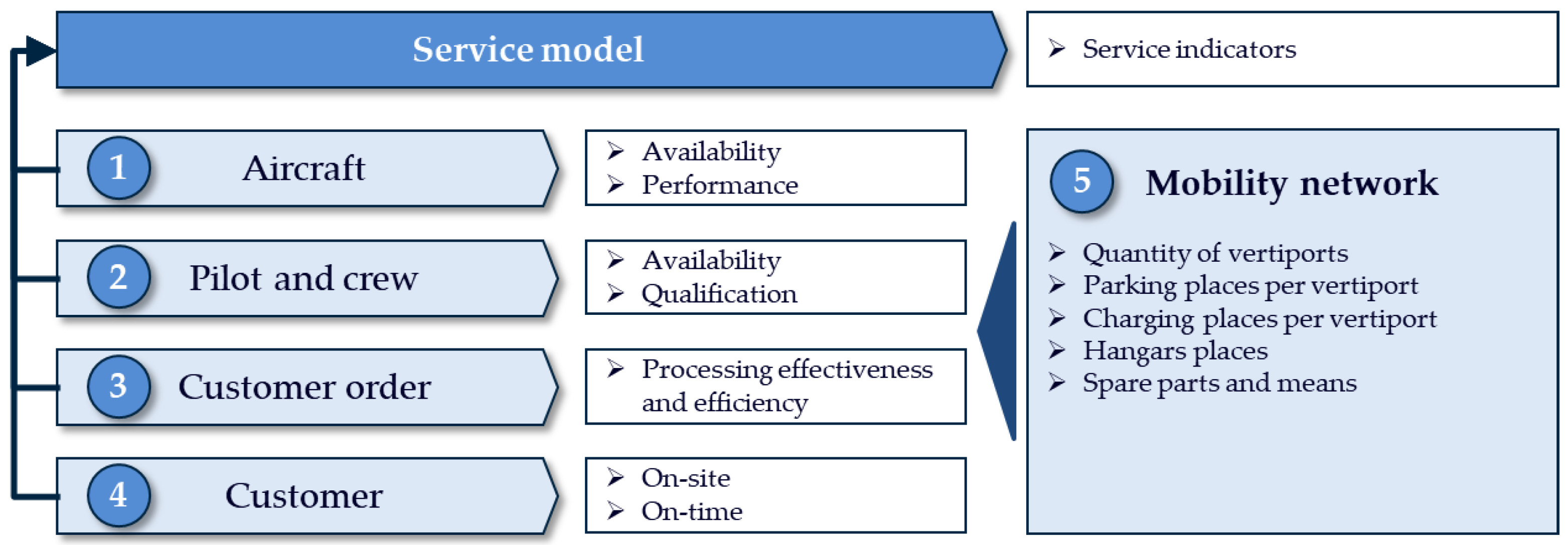

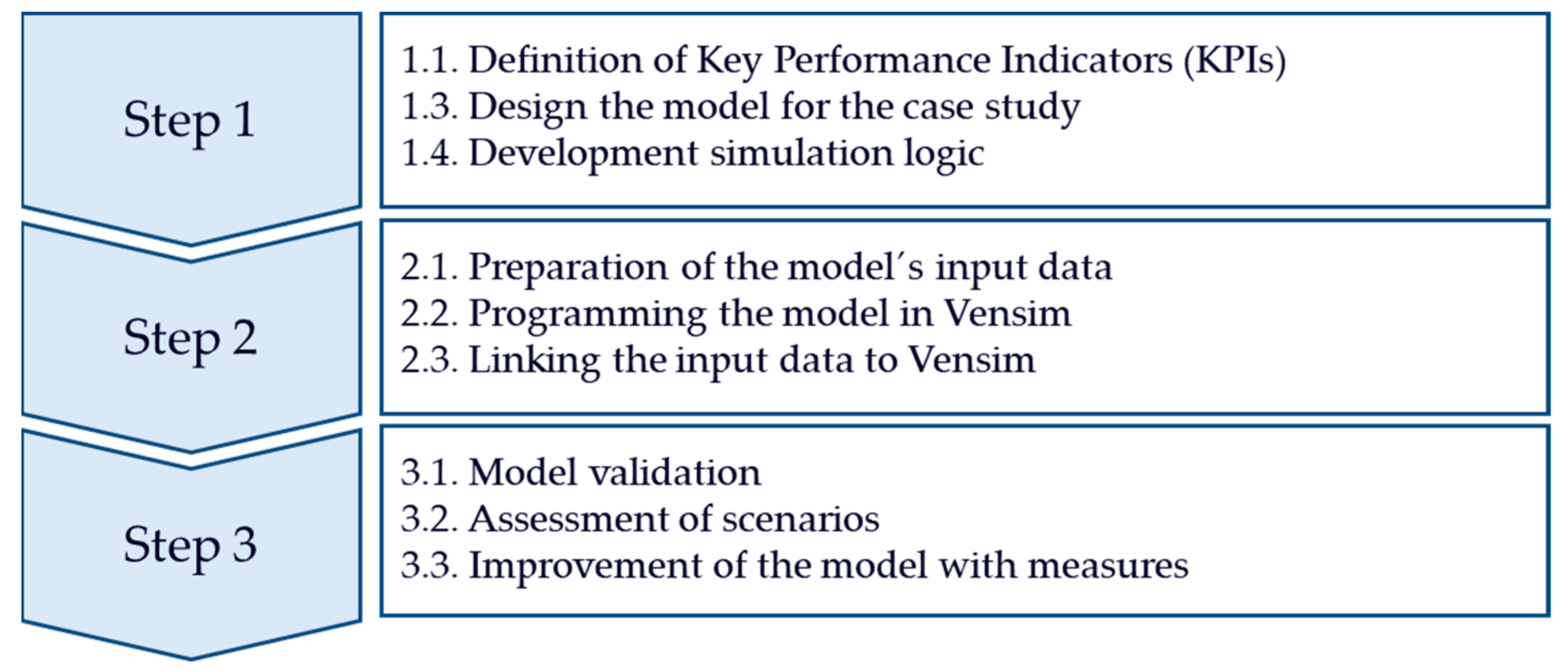





| No. | Key Performance Indicators (KPIs), Units, and Formulas | |
|---|---|---|
| Indicator | Formula | |
| 1 | Passengers (persons) | |
| 2 | Average aircraft on ground (%) | |
| 3 | Average aircraft availability (%) | 100%-Average Maintenance time (%) |
| 4 | Average aircraft utilization rate (%) | 100%-Average aircraft on ground (%) |
| 5 | Average flight request backlog (# requests) | |
| 6 | Average flight request backlog (minutes) | |
| 7 | Average capacity utilization rate of vertiports (%) | |
| 8 | Average vertiports full (%) | |
| 9 | Average vertiports empty (%) | |
| 10 | Average arrival backlog (aircraft units) | |
| 11 | Average arrival backlog (minutes) | |
| No. | Indicator | High Performance | Low Performance |
|---|---|---|---|
| 1 | Passengers (# persons) | 6888 | 6720 |
| 2 | Average aircraft on ground (%) | 81.99 | 82.43 |
| 3 | Average aircraft availability (%) | 98.7 | 72.2 |
| 4 | Average aircraft utilization rate (%) | 18.01 | 17.57 |
| 5 | Average flight request backlog (# requests) | 6.1 | 8.2 |
| 6 | Average flight request backlog (minutes) | 8.3 | 10.3 |
| 7 | Average capacity utilization rate of vertiports (%) | 43 | 50 |
| 8 | Average vertiports full (%) | 14.7 | 20.3 |
| 9 | Average vertiports empty (%) | 14.1 | 11.8 |
| 10 | Average arrival backlog (aircraft units) | 10.4 | 12.5 |
| 11 | Average arrival backlog (minutes) | 5.8 | 7.6 |
| No. | Indicator | Redistribution Model | No Redistribution Model |
|---|---|---|---|
| 1 | Passengers (# persons) | 6888 | 6773 |
| 2 | Average aircraft on ground (%) | 81.99 | 82.29 |
| 3 | Average aircraft availability (%) | 98.7 | 98.7 |
| 4 | Average aircraft utilization rate (%) | 18.01 | 17.71 |
| 5 | Average flight request backlog (# requests) | 6.1 | 25.7 |
| 6 | Average flight request backlog (minutes) | 8.3 | 12.9 |
| 7 | Average capacity utilization rate of vertiports (%) | 43 | 42 |
| 8 | Average vertiports full (%) | 14.7 | 28.3 |
| 9 | Average vertiports empty (%) | 14.1 | 28.4 |
| 10 | Average arrival backlog (aircraft units) | 10.4 | 47.9 |
| 11 | Average arrival backlog (minutes) | 5.8 | 9.9 |
Publisher’s Note: MDPI stays neutral with regard to jurisdictional claims in published maps and institutional affiliations. |
© 2022 by the authors. Licensee MDPI, Basel, Switzerland. This article is an open access article distributed under the terms and conditions of the Creative Commons Attribution (CC BY) license (https://creativecommons.org/licenses/by/4.0/).
Share and Cite
Winkler, P.; Gallego-García, S.; Groten, M. Design and Simulation of a Digital Twin Mobility Concept: An Electric Aviation System Dynamics Case Study with Capacity Constraints. Appl. Sci. 2022, 12, 848. https://doi.org/10.3390/app12020848
Winkler P, Gallego-García S, Groten M. Design and Simulation of a Digital Twin Mobility Concept: An Electric Aviation System Dynamics Case Study with Capacity Constraints. Applied Sciences. 2022; 12(2):848. https://doi.org/10.3390/app12020848
Chicago/Turabian StyleWinkler, Philipp, Sergio Gallego-García, and Marcel Groten. 2022. "Design and Simulation of a Digital Twin Mobility Concept: An Electric Aviation System Dynamics Case Study with Capacity Constraints" Applied Sciences 12, no. 2: 848. https://doi.org/10.3390/app12020848
APA StyleWinkler, P., Gallego-García, S., & Groten, M. (2022). Design and Simulation of a Digital Twin Mobility Concept: An Electric Aviation System Dynamics Case Study with Capacity Constraints. Applied Sciences, 12(2), 848. https://doi.org/10.3390/app12020848







